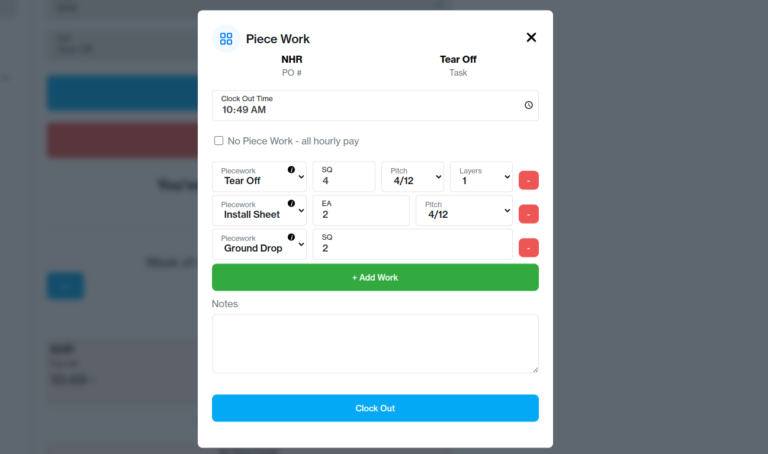Is Piece Work Right for Your Business? Best Questions to Ask
Table of Contents
- Introduction
- Understanding Piece Work
- Key Questions to Ask Yourself
- Real-World Benefits of Piece Work
- Possible Drawbacks to Consider
- Tools That Make Piece Work Easier
- Preparing Your Business for Piece Work
- Conclusion
Introduction
Many companies pay employees by the hour, but some jobs work better with a different approach. Piece work is a system where workers earn money based on the number of units or tasks they complete. In the roofing industry, for example, a roofer might earn a set rate for each square of shingles they install. This approach can reward people who work faster and still maintain good quality.
But is piece work right for your business? Adopting this model may save time and money, yet it can also lead to problems if you are not prepared. This article discusses what piece work is, why some businesses choose it, and the questions you should ask before deciding to use it. It also looks at common benefits, possible drawbacks, and tools that make the system run more smoothly. By the end, you will have a better sense of whether piece work fits your needs and how to set it up if you decide to give it a try.
Understanding Piece Work
Piece work means paying someone for each item completed or task finished. For a roofing crew, tasks might include installing squares of shingles, laying ridge caps, or even handling flashing around vents. Instead of watching the clock, each worker tracks how many squares or other pieces they install. Then, wages come from the total of those completed units times a set rate per piece.
Why Companies Use It
- Motivation: Workers can earn more by producing more, so high performers may prefer a piece rate system.
- Efficiency: Paying by the piece can reduce wasted time, since crews often focus on finishing tasks faster.
- Cost Control: Piece work helps managers see exactly how much labor costs for each job. If you know how many pieces were installed, you can track labor expenses in detail.
Where It Works Best
Piece work is most helpful in fields where tasks are easy to measure. Roofing is a classic example, because each square or other piece of roofing has clear boundaries. Factories and agriculture often use piece work too, since units like products assembled or crates of produce picked are simple to count.
Key Questions to Ask Yourself
Before you shift your business to piece work, there are a few questions worth exploring. By addressing these questions, you can avoid surprises and help workers thrive in the new system.
- Is the Work Easy to Measure in Units?
For piece work to run smoothly, tasks need a clear “unit” that can be counted. In roofing, this is often squares of shingles. In another job, it might be number of items assembled. If your work is not easy to measure, consider a different pay system or use piece work for only part of what your team does. - Can You Track Both Hours and Pieces?
Some managers think piece work means they never have to track time again. In many places, though, labor laws require you to track hours to confirm minimum wage or overtime rules. You also need a way to log pieces. If you do not have a plan to track both, piece work may lead to issues later. - Will Piece Work Stay Fair for Everyone?
Certain tasks might be harder or easier to complete. If one worker always gets the easiest tasks, they might earn more, while others feel cheated. Decide how to rotate tasks or set up fair rules. Think about quality checks too, so you do not end up paying for rushed or sloppy work. - Do You Have a Process for Handling Quality?
When speed is rewarded, some workers may skip steps. That is why a strong quality check matters. If a job is poorly done, you may need a system where it does not count or must be fixed at the worker’s own time. - Are You Prepared for Record-Keeping?
Piece work systems run best with good record-keeping. That means daily logs of what each person did and how many pieces they completed. If you skip records, you might face disagreements during payroll. - How Will You Handle Pay Rates?
A fair piece rate is not always easy to figure out. It helps to measure how long it takes an average worker to finish one piece, then multiply that by a fair hourly wage. You might adjust up or down from there to reflect skill levels, complexity, or market rates for your industry.
Real-World Benefits of Piece Work
Piece work may bring significant benefits, especially in industries with clear tasks like roofing. Below are some of the main advantages.
- Higher Productivity
When workers know they can earn more by completing tasks quickly, they often become more focused. This can lead to shorter project times and more jobs completed in a day or week. - Better Cost Control
For each job, managers see exactly how many pieces were finished. That means they have a direct record of labor costs. This is helpful for job costing—analyzing profit and identifying where money might be lost. - Rewarding Skilled Workers
People who excel at their tasks can earn more in a piece rate system. They do not have to wait for raises that might come with a yearly review. As soon as they produce more, they see a benefit in their pay. - Clear Goals
Piece work sets a direct target: install this many squares, earn this amount of money. Teams know exactly what is expected of them, and managers can see which tasks get done each day.
Possible Drawbacks to Consider
Piece work can improve your business, but it also comes with potential issues. Planning ahead can keep these problems from becoming serious.
- Risk of Lower Quality
Workers focused on speed might cut corners or do tasks in a rush. Without a quality-check system, you might face higher repair costs or client complaints. - Unfair Task Distribution
If tasks are not assigned equally, one worker might do all the tough parts while another gets the easy work. This can cause conflict or low morale. - Complex Payroll
Tracking both hours (for labor law reasons) and pieces (for pay) can become a burden if you rely on paper sheets or multiple spreadsheets. - Training Needs
Switching from hourly pay to piece work can be a big shift. Employees might need training on how to enter daily amounts or understand piece rates. Without clear guidance, confusion and mistakes may arise.
Tools That Make Piece Work Easier
Some of these potential problems are simpler to handle with the right tools. Digital systems can bring all the important information—time tracking, piece counts, job costing—into one place.
- Time Clock Apps
Workers log in and out with a mobile app or web platform. This creates a digital record of hours, which is vital for labor compliance. - Piece Tracking Software
Instead of guessing how many squares were installed, each worker enters that number daily. This data instantly ties to payroll, so you do not have to transfer numbers by hand. - Quality Checks
A good platform can flag if a worker logs an unusually high number of pieces compared to others. Managers can then do a quick check for quality. - Payroll Reports
When time cards and piece counts live in one system, you can approve them with a click. Some systems, such as Piece Work Pro, even provide job costing reports that reveal how much you paid out on each project.
Digital tools cut down on mistakes and keep everyone on the same page. They also make it easier for managers to respond quickly if they see patterns that need attention, like a worker who might need help with technique or training.
Preparing Your Business for Piece Work
If you decide piece work might be right for your business, you can follow these steps to make the transition smoother:
- Run a Small Test
Try piece work on a single project or a single crew. Collect feedback from workers, check the data, and see if the results match your goals. - Set Transparent Rates
Make sure everyone understands how they can earn money per piece. Post these rates clearly or share them in digital form. Some tasks may have different rates if they require more skill or time. - Train Your Team
Show workers how to log their pieces at the end of each day. Explain why you track hours. Teach them about the importance of quality, so they know rushing is not the only priority. - Check Compliance
Confirm that workers still meet minimum wage and overtime requirements if your local laws demand it. Keep records of hours worked. - Use Feedback Loops
Talk to crews regularly. Ask if the piece rate feels fair or if any tasks are paid too low or too high. Adjust as needed. - Monitor and Improve
Check job costing reports to see if you are meeting or exceeding profit goals. If not, see where costs went up. Maybe a piece rate is too generous for tricky tasks, or maybe your crew needs better equipment.
Conclusion
Piece work can be a powerful system for businesses where tasks can be easily counted. It often boosts productivity, helps control labor costs, and rewards hardworking employees who can handle more tasks in less time. However, it also comes with risks, such as reduced quality or uneven task assignments. That is why setting up the right structure is so important.
By considering the questions listed in this article—like how to track hours and units, how to ensure fairness, and how to maintain quality—you can decide if piece work suits your company. If you do switch to piece work, modern tools can help reduce errors and speed up payroll. They also allow for real-time insights, so you can spot issues or successes quickly.
When run properly, piece work builds a direct connection between the effort workers put in and the pay they receive. It can also give managers the data they need to make smart choices about job costing and scheduling. With good planning and a willingness to adapt, piece work may give your business the boost it needs to operate more efficiently and stay competitive in your industry.



